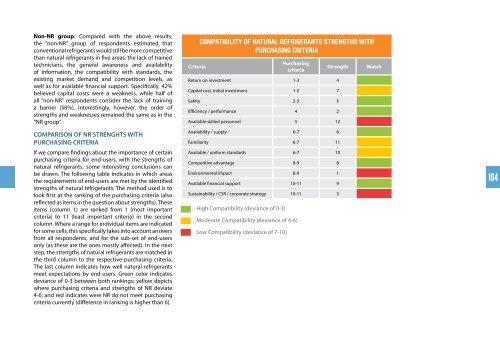TABLE OF CONTENTS - Everything R744
TABLE OF CONTENTS - Everything R744
TABLE OF CONTENTS - Everything R744
Create successful ePaper yourself
Turn your PDF publications into a flip-book with our unique Google optimized e-Paper software.
Non-NR group: Compared with the above results,<br />
the “non-NR” group of respondents estimated that<br />
conventional refrigerants would still be more competitive<br />
than natural refrigerants in five areas: the lack of trained<br />
technicians, the general awareness and availability<br />
of information, the compatibility with standards, the<br />
existing market demand and competition levels, as<br />
well as for available financial support. Specifically, 42%<br />
believed capital costs were a weakness, while half of<br />
all “non-NR” respondents consider the lack of training<br />
a barrier (50%). Interestingly, however, the order of<br />
strengths and weaknesses remained the same as in the<br />
“NR group”.<br />
COMPARISON <strong>OF</strong> NR STRENGHTS WITH<br />
PURCHASING CRITERIA<br />
If we compare findings about the importance of certain<br />
purchasing criteria for end-users, with the strengths of<br />
natural refrigerants, some interesting conclusions can<br />
be drawn. The following table indicates in which areas<br />
the requirements of end-users are met by the identified<br />
strengths of natural refrigerants. The method used is to<br />
look first at the ranking of the purchasing criteria (also<br />
reflected as items in the question about strengths). These<br />
items (column 1) are ranked from 1 (most important<br />
criteria) to 11 (least important criteria) in the second<br />
column. Where a range for individual items are indicated<br />
for some cells, this specifically takes into account answers<br />
from all respondents, and for the sub-set of end-users<br />
only (as these are the ones mostly affected). In the next<br />
step, the strengths of natural refrigerants are matched in<br />
the third column to the respective purchasing criteria.<br />
The last column indicates how well natural refrigerants<br />
meet expectations by end-users. Green color indicates<br />
deviance of 0-3 between both rankings; yellow depicts<br />
where purchasing criteria and strengths of NR deviate<br />
4-6; and red indicates were NR do not meet purchasing<br />
criteria currently (difference in ranking is higher than 6).<br />
Criteria<br />
Compatibility of Natural Refrigerants Strengths with<br />
Purchasing Criteria<br />
Purchasing<br />
criteria<br />
Strength<br />
Return on investment 1-3 4<br />
Capital cost, initial investment 1-2 7<br />
Safety 2-3 5<br />
Efficiency / performance 4 2<br />
Available skilled personnel 5 12<br />
Availability / supply 6-7 6<br />
Familiarity 6-7 11<br />
Available / uniform standards 6-7 10<br />
Competitive advantage 8-9 8<br />
Environmental impact 8-9 1<br />
Available financial support 10-11 9<br />
Sustainability / CSR / corporate strategy 10-11 3<br />
High Compatibility (deviance of 0-3)<br />
Moderate Compatibility (deviance of 4-6)<br />
Low Compatibility (deviance of 7-10)<br />
Match<br />
104

















